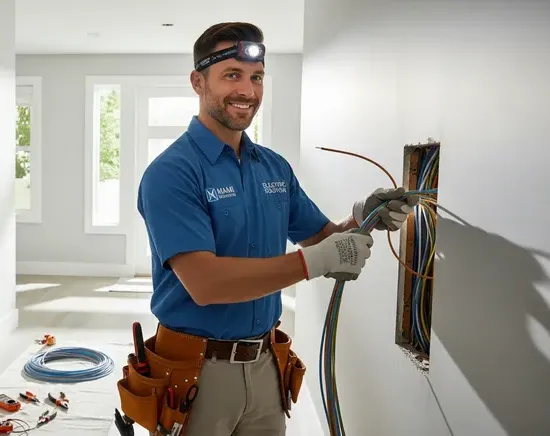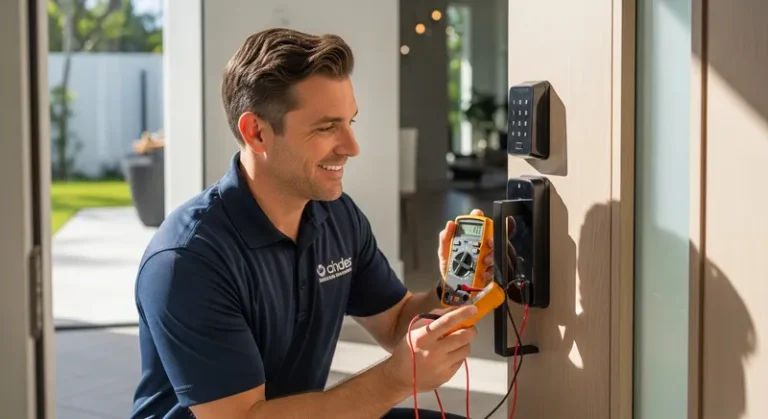How to Fix Electrical Issues in Fort Lauderdale
To fix electrical issues in Fort Lauderdale, start by identifying common problems like circuit overloads, flickering lights, and tripped breakers. Always prioritize safety; use insulated gloves and turn off power before working. For flickering lights, check bulb installation and unplug unnecessary devices. If breakers trip frequently, locate the affected circuit and reset the breaker. Regular inspections and maintenance can help prevent future issues. You’ll discover key steps for tackling faulty outlets and maintaining your electrical system effectively.
Key Takeaways
- Identify and unplug unnecessary appliances to address circuit overloads and prevent tripped breakers.
- Regularly inspect wiring and outlets for damage or corrosion to maintain electrical safety.
- Check and securely install light bulbs to resolve flickering issues before consulting a professional.
- Turn off the power at the circuit breaker before performing any electrical work for safety.
- Schedule routine inspections and upgrades to ensure compliance with current safety standards.
Understanding Common Electrical Problems
Electrical issues can disrupt daily life and even pose safety hazards. One common problem you might encounter is circuit overloads, which occur when too many devices draw power from a single circuit. This can lead to tripped breakers or even electrical fires.
Another issue could be outdated wiring; if your home hasn’t had any wiring upgrades in years, it likely can’t handle modern electrical demands. Signs of trouble include flickering lights, burning smells, or frequently blown fuses.
Addressing these problems promptly is vital for maintaining a safe and functional electrical system. Regular inspections and necessary upgrades can help you avoid serious hazards and guarantee your electrical system meets current safety standards.
Stay proactive to keep your home safe and running smoothly.
Safety First: Precautions to Take
When dealing with electrical issues, taking safety precautions is paramount.
First, make sure you have the right safety equipment on hand, such as insulated gloves, safety goggles, and a sturdy ladder. Always turn off the power at the circuit breaker before starting any work.
Familiarize yourself with emergency procedures in case of an electrical shock or fire. Keep a fire extinguisher nearby, specifically rated for electrical fires.
If you’re uncertain about your skills, don’t hesitate to consult a professional. Remember, it’s better to be safe than sorry.
By following these guidelines, you can minimize risks and protect yourself while addressing electrical problems efficiently.
Stay vigilant and prioritize safety at all times.
Diagnosing Flickering Lights
Flickering lights can be both annoying and indicative of underlying electrical issues that need attention.
First, check if the flickering bulbs are securely installed; loose connections can cause inconsistent power flow.
If the bulbs are fine, consider whether you’re experiencing a circuit overload. This occurs when too many devices draw power from a single circuit, leading to voltage fluctuations.
Try unplugging some devices to see if that resolves the issue.
If flickering persists, inspect the wiring for damage or corrosion, as these can also disrupt the electrical flow.
In some cases, it’s wise to consult a professional electrician to diagnose and fix more serious issues, ensuring the safety and functionality of your electrical system.
Troubleshooting Tripped Breakers
Sometimes, a tripped breaker can signal an underlying issue that needs immediate attention. Start by identifying the cause, often due to circuit overloads.
Check which devices are connected to the affected circuit and unplug any unnecessary appliances. Once you’ve reduced the load, locate your breaker panel. The tripped breaker will be in the “off” position or in a neutral state.
To execute the reset procedure, firmly switch the breaker to the “off” position, then back to “on.” If it trips again, there could be a more serious problem, such as a short circuit or faulty wiring.
In that case, it’s best to consult a licensed electrician to guarantee your safety and compliance with local codes.
Fixing Faulty Outlets
You might encounter faulty outlets that fail to provide power, which can disrupt your daily activities. To address this issue, you should perform thorough outlet testing first to identify the problem.
If the outlet is indeed faulty, outlet replacement is necessary. Here’s how to proceed:
- Turn off the power at the circuit breaker to guarantee safety.
- Remove the outlet cover and unscrew the outlet from the wall.
- Disconnect the wires and replace the old outlet with a new one, guaranteeing proper connections.
Make sure the new outlet is rated for the correct amperage and voltage.
After installation, turn the power back on and test the outlet to confirm it’s functioning correctly. This fixes the issue and restores your electrical supply.
Dealing With Electrical Surges
After addressing faulty outlets, it’s important to be aware of electrical surges that can damage your appliances and electronics. Surges occur when there’s a sudden increase in voltage, often caused by lightning strikes or power grid fluctuations.
To safeguard your devices, invest in surge protection devices (SPDs) that can absorb excess voltage and maintain stability. Confirm your home’s wiring is equipped for voltage stability, which helps prevent damage during surges.
You might also consider whole-house surge protectors for extensive coverage. Regularly inspect your electrical system and replace any outdated components to minimize risks.
Maintaining Your Electrical System
Regular maintenance of your electrical system is crucial to guarantee safety and efficiency. By implementing a routine of circuit maintenance and conducting regular inspections, you can identify potential issues before they escalate.
Here are some key practices to follow:
- Inspect circuit breakers for signs of wear or damage.
- Check outlets and switches for any unusual heat or discoloration.
- Test smoke detectors and GFCI outlets monthly to verify they’re functioning properly.
These steps not only enhance the longevity of your electrical system but also provide peace of mind.
Remember, proactive care minimizes risks and helps maintain peak performance, ensuring that your home remains safe and energy-efficient.
Always prioritize your electrical system’s health to avoid costly repairs down the line.
When to Call a Professional Electrician
Knowing when to call a professional electrician can prevent minor electrical issues from becoming major hazards.
If you notice flickering lights, frequent circuit breaker trips, or burning smells, these are critical signs of urgency that require immediate attention.
Don’t ignore recurring problems, as they may indicate underlying issues that can escalate.
When choosing an electrician, make certain they’re licensed and insured, with positive reviews and relevant experience.
Ask for quotes and verify their credentials to avoid potential scams.
Remember, safety should always come first.
If you’re unsure about the severity of the issue, it’s better to err on the side of caution and consult a professional.
Taking these steps will help make certain your electrical system remains safe and functional.
About Us
We understand that electrical issues can be stressful and overwhelming. That’s why we are here to lend a helping hand and provide you with the best electrical services in town. As a team of experienced electricians, we take pride in our ability to solve any electrical problem with precision and care.
Pages
Follow us
© 2025 By Electrician Fort Lauderdale Today







